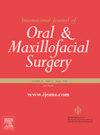预后三要素:I-II 期口腔鳞状细胞癌辅助治疗决策的新方法。
IF 2.2
3区 医学
Q2 DENTISTRY, ORAL SURGERY & MEDICINE
International journal of oral and maxillofacial surgery
Pub Date : 2025-01-01
DOI:10.1016/j.ijom.2024.07.004
引用次数: 0
摘要
本研究提出了口腔鳞状细胞癌(OSCC)I/II期辅助照射的评分系统。研究纳入了衍生队列(119 例患者,手术时间为 2011 年至 2014 年)和验证队列(204 例患者,手术时间为 2016 年至 2019 年)。在衍生队列中,单变量分析显示,肿瘤大小大于2厘米[3年无病生存率(DFS)72.5% vs 95.6%,P = 0.039]、淋巴管侵犯(58.3% vs 83.6%,P = 0.024)、神经周围侵犯(75% vs 85.6%,P = 0.013)和侵犯深度≥0.5厘米(73.8% vs 97.5%,P = 0.017)预测3年无病生存率。根据之前发表的报告,舌部病变和分化不良也是预后不良的因素。患者被分为低风险 (本文章由计算机程序翻译,如有差异,请以英文原文为准。
Prognostic triad: a novel method for decision-making for adjuvant treatment in stage I–II oral squamous cell carcinoma
This study proposes a scoring system for adjuvant irradiation for stage I/II oral squamous cell carcinoma (OSCC). Derivation cohort (119 patients, operated between 2011 and 2014) and a validation cohort (204 patients, operated between 2016 and 2019) were included. In derivation cohort, on univariate analysis, tumor size >2 cm [3-year Disease Free Survival (DFS) 72.5% vs 95.6%, P = 0.039], lymphovascular invasion (58.3% vs 83.6%, P = 0.024), perineural invasion (75% vs 85.6%, P = 0.013), and depth of invasion ≥0.5 cm (73.8% vs 97.5%, P = 0.017) predicted 3-year DFS. Tongue lesions and poor differentiation were added as poor prognosticators based on previously published reports. Patients were grouped as low risk (<3 risk factors) and high risk (≥3 risk factors), with only high-risk group receiving adjuvant irradiation in validation cohort. Overall, 47/119 (39.5%) patients in the derivation cohort and 50/204 (24.5%) patients in validation cohort received adjuvant irradiation. In derivation cohort, 3-year DFS was 93% and 72.5% in the low and high-risk group, respectively. 3-year DFS was 90.7% and 85.8% in the low and high-risk group, respectively for validation cohort. The proposed scoring system reduced the use of adjuvant irradiation by 38%, with similar DFS.
求助全文
通过发布文献求助,成功后即可免费获取论文全文。
去求助
来源期刊
CiteScore
5.10
自引率
4.20%
发文量
318
审稿时长
78 days
期刊介绍:
The International Journal of Oral & Maxillofacial Surgery is one of the leading journals in oral and maxillofacial surgery in the world. The Journal publishes papers of the highest scientific merit and widest possible scope on work in oral and maxillofacial surgery and supporting specialties.
The Journal is divided into sections, ensuring every aspect of oral and maxillofacial surgery is covered fully through a range of invited review articles, leading clinical and research articles, technical notes, abstracts, case reports and others. The sections include:
• Congenital and craniofacial deformities
• Orthognathic Surgery/Aesthetic facial surgery
• Trauma
• TMJ disorders
• Head and neck oncology
• Reconstructive surgery
• Implantology/Dentoalveolar surgery
• Clinical Pathology
• Oral Medicine
• Research and emerging technologies.

 求助内容:
求助内容: 应助结果提醒方式:
应助结果提醒方式:


